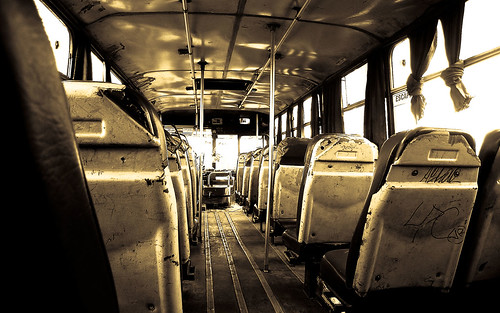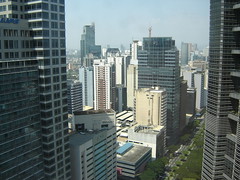
Mobilizing the political will
to improve public transit in Metro Manila
Part 1: A sense of urgency
This begins my long promised post on how to get better public transportation (in particular: bus rapid transit or BRT) in Metro Manila.
The first thing we have to doThe first thing we have to do is to
create a sense of urgency.
To do that, we have to change the frame of the conversation.
Ask anyone in Metro Manila about the "effects of bad public transportation" and invariably they will say
bad traffic. Granted that PUV driving behavior (caused by
the economic model) does cause traffic chaos, to put that first on the list of adverse effects of bad public transportation is to be myopic.
Traffic congestion is the most visible effect -but it is largely visible to car users. What is invisible and ignored is the effect bad public transportation has on the urban poor and lower middle classes who are dependent on PUVs to get from home to school or to work.
That segment is the fat part of the pyramid, almost 80% of daily person trips in Metro Manila are taken via public transport. Despite the overwhelming size of this cohort, I have yet to see statistics that detail the consequences of the inefficient system on the riding public.
Whatever conversations about public transit that is covered by the papers centers around fare prices and the issues of the operators and drivers. Their regular threats to hold transport strikes and their near constant refrains of the fares being too low to support their livelihood and their complaints about harassment from the MMDA and the local police. (I am not discounting those complaints, only saying that they have become monotonous.)
The questions we need to ask are: what are the economic and social effects of an inefficient public transport on the riding public in general, and the urban poor in particular? What are the comparative efficiency advantages (e.g. -time) of driving a private car vs. taking the bus or jeep? Specifically we need to ask:
- How much of the household budget does transportation consume? (Particularly for the C,D and E classes.) -and this should cover the costs of car ownership (purchase, maintenance and operation) as well as the costs of fares for all modes of public transit.
- How much more time does it take to get from home to work or home to school when you take public transit (all modes) vs. a private car?
- What is the social cost of the inefficiency and bias towards cars? How much less time do parents in families without cars have to spend with their children? Do students have to rent at boarding houses because it is just not feasible to travel from home to school daily?
My own back of the envelope (read: totally unscientific) calculations make me think transportation eats up about 20% of the household budget of middle class families -and that share could rise up to about a third in poorer families.
I suspect that the inefficient PUV system offsets the daily schedule of transit riders by 1.5 to 2 hours a day vs. private car owners. That's about 20 hours a week of bias for car owners.
But again, these are all just estimates. We need to demand that someone study the real numbers -or bring the stats out if there have already been studies.
We need to bring these issues to the public sphere and we need to frame this as an urgent social justice issue.
Imagine the direct impact you could have on the quality of life of the middle class and the urban poor if you could at least halve that time bias. You would be giving parents 10 more hours a week with their families; giving mothers and fathers an extra hour a day to tend to their children; giving students respite from the grueling time spent on the road or giving them the option of not having to pay for room and board just to live closer to school.
We need to make efficient public transport more important than traffic congestion.
Next up: Part 2: A promise of what is possible









